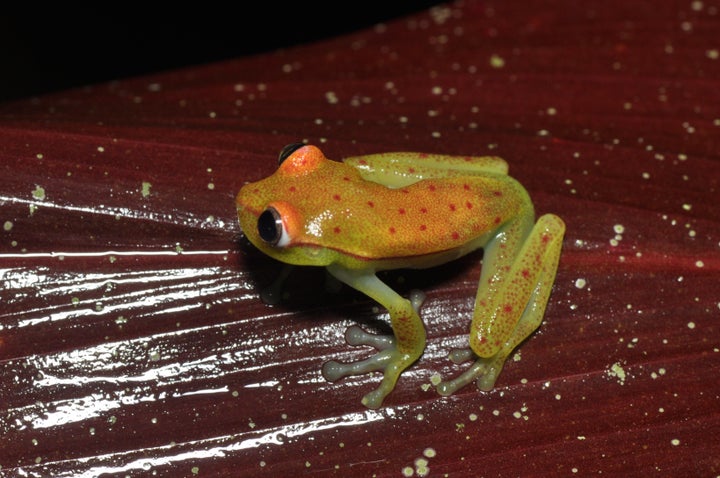A new light has been cast on the world of frogs following a dazzling discovery in South America.
Scientists announced last week that they’d discovered the world’s first known naturally fluorescent amphibian. In a March 13 paper published in the Proceedings of the National Academy of Sciences, researchers described how the tiny and nocturnal South American polka dot tree frog (Hypsiboas punctatus) transforms from a dull chartreuse shade with reddish spots to a striking neon hue when ultraviolet light is shone upon it.
It’s a “surprising” discovery, study co-author Norberto Peporine Lopes, a chemist at the University of São Paulo in Brazil, told The Huffington Post in an email this week. “When we trained a UVA flashlight, or black light, on specimens of H. punctatus, the entire animal gave off an intense greenish-blue glow.”
Biofluorescence is found in marine creatures including corals, several species of fish, mantis shrimp, sharks and a species of sea turtle; but the phenomenon is much more unusual among terrestrial animals.
Previously, only parrots, certain butterflies, and some arthropods, including scorpions and spiders, were known to have fluorescent qualities. Unique from bioluminescence, which is the production and emission of light via chemical reactions, biofluorescence is the ability of skin or feathers or other organic surface to absorb short-wavelength electromagnetic radiation and re-emit it as longer wavelength light.
In the case of the fluorescent frog, a unique group of three molecules ― hyloin-L1, hyloin-L2 and hyloin-G1― appear to be responsible for the amphibian’s glow, researchers said.
The molecules, found in the frog’s lymph tissue, skin and glandular secretions, contain a ring structure and a chain of hydrocarbons ― an “amazing” arrangement unlike other known molecules that cause fluorescence in animals, Lopes told NPR.
“It’s a new chemistry,” he said.
The closest known compounds are found in plants.
The three molecules were also discovered to have the ability to emit an impressive amount of light, said the scientists ― giving off approximately 18 percent as much visible light as a full moon.

Researchers said it remains unclear why the polka dot tree frog has this fluorescent ability, though communication, specifically for mating purposes, is one possibility.
Lopes said the next step is to study the visual perception of the species to discover if they can see their own fluorescence. Researchers are also trying to find out whether there are other amphibians with similar glow-in-the-dark capabilities in existence.
“Our results introduce an unprecedented source of pigmentation in amphibians and highlight the potential relevance of fluorescence in visual perception in terrestrial environments,” Lopes said.
Study co-author Julián Faivovich, a herpetologist at the University of Buenos Aires, told Nature he’s eager to start looking for fluorescence in other amphibians. Possible candidates include 250 other tree frog species that, like the polka dot tree frog, have translucent skin.
“I’m really hoping that other colleagues will be very interested in this phenomenon, and they will start carrying a UV flashlight to the field,” he said.